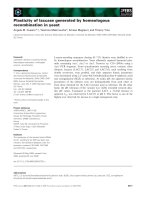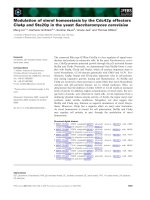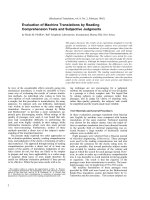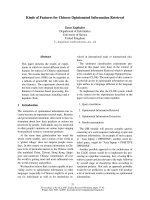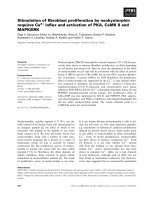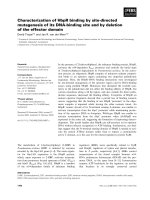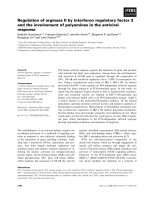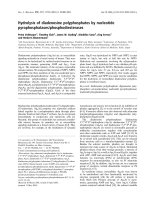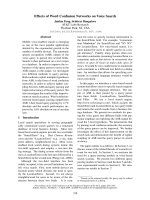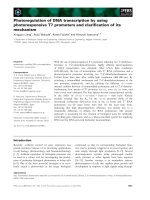báo cáo khoa học: " Internalization of ferromagnetic nanowires by different living cells" pdf
Bạn đang xem bản rút gọn của tài liệu. Xem và tải ngay bản đầy đủ của tài liệu tại đây (1.13 MB, 11 trang )
BioMed Central
Page 1 of 11
(page number not for citation purposes)
Journal of Nanobiotechnology
Open Access
Research
Internalization of ferromagnetic nanowires by different living cells
Adriele Prina-Mello*, Zhu Diao and John Michael David Coey
Address: Centre for Research on Adaptive Nanostructures and Nanodevices (CRANN) and School of Physics. Trinity College Dublin, Dublin 2,
Ireland
Email: Adriele Prina-Mello* - ; Zhu Diao - ; John Michael David Coey -
* Corresponding author
Abstract
The ability of living cells, either adherent or suspended, to internalize nickel nanowires is
demonstrated for MC3T3-E1, UMR106-tumour and Marrow-Stromal cells. Nanowires were
produced by electrodeposition, 20 μm long and 200 nm in diameter. Cell separation and
manipulation was achieved for the three cell types. Applied magnetic field successfully oriented the
internalized nanowires but no clear anisotropy is induced on the adherent cells. Nanowires tend
to bind to cytoplasm metalloproteins and trigger lysosome reorganization around the nucleus. This
work demonstrates the applications of nanowires in adherent and suspended cells for cell
separation and manipulation, and further explore into their role in nanobiotechnology.
Background
Ferromagnetic nanoparticles have found widespread uses
in modern biology and medicine [1-3]. They are used as
contrast agents for magnetic resonance imaging [4], local-
ized radio-frequency heating [5] and applying mechanical
stress in magnetic tweezers [6]. Applications include func-
tionalized labeling [3] for separation [7], drug delivery
[8], imaging and detection [9]. Most current cell labeling
techniques use one of two approaches: (1) attaching mag-
netic nanoparticles to the cell surface or (2) internalizing
the nanoparticles by fluid phase endocytosis [10].
Studies of ferromagnetic nanowires are much less
advanced. The advantages over the use of nanowires
instead of nanoparticles are related to the favourable geo-
metrical anisotropy, the increased surface to volume ratio
and dipolar magnetic properties linked to the nanowire
shape. Furthermore by using magnetic nanowires with
large permanent magnetic moments it is possible to
increase the range and effectiveness of such magnetic
interactions to respond to the weak fields at a distance
from external magnets.
Techniques are well developed to produce these wires by
electrodeposition into porous anodized alumina tem-
plates in milligram quantities, and it is possible to tailor
their length by changing the deposition time, and their
diameter by choosing a suitable template [13,14,16]. The
wire composition may be uniform or variable along the
length of the wire by varying the conditions of elec-
trodeposition. The ability to code information and spa-
tially-varying functionality into the nanowires, as well as
their shape anisotropy, means that they have a potentially
greater range of useful applications than nanoparticles.
Recently it has been shown by Reich and co-workers
[7,11,12] that nanowires can be internalized by immortal-
ized fibroblasts, and can be used in biotechnological
applications. There, the optimization and yield of mag-
netic nanowires was carried out as an alternative to mag-
Published: 05 September 2006
Journal of Nanobiotechnology 2006, 4:9 doi:10.1186/1477-3155-4-9
Received: 21 June 2006
Accepted: 05 September 2006
This article is available from: />© 2006 Prina-Mello et al; licensee BioMed Central Ltd.
This is an Open Access article distributed under the terms of the Creative Commons Attribution License ( />),
which permits unrestricted use, distribution, and reproduction in any medium, provided the original work is properly cited.
Journal of Nanobiotechnology 2006, 4:9 />Page 2 of 11
(page number not for citation purposes)
netic particle separation system and as a cell sorting and
positioning system.
The orientation and manipulation of adherent cells by
internalized magnetic nanowires has not been extensively
exploited [7]. Information in literature is restricted to just
one cell type, NIH 3T3 mouse fibroblast cells [7,11,12].
Here we investigate a range of cells – undifferentiated, dif-
ferentiated and tumour cells – and show how they can
absorb nickel nanowires in the adherent and suspended
states. We investigate the possibility of alignment of these
cells in an external magnetic field, with a view towards the
alignment of cells for preferential tissue regeneration and
bone growth. Finally, we also speculate about the cellular
internalization process and activated cytoplasmic mecha-
nism.
Results
Magnetic properties of nanowires
The X-ray diffraction pattern of the SEM imaged
nanowires (Fig. 1), showed a single Ni phase pattern (Fig.
2) (powder diffraction, X-rays wavelength of CuKa (λ =
1.5418 Å), 2-θ values in agreement with JCPDS No:04-
0850). The room-temperature magnetization curve of the
nickel nanowires is shown in Fig. 3. The saturation mag-
netization is 50.7 Am
2
kg
-1
, which is significantly less than
the value for bulk nickel (55.4 Am
2
kg
-1
). The EDAX anal-
ysis indicated an O/Ni ratio of 1:15, hence it seems likely
that the surface of the wires is coated with a layer of nickel
oxide which is approximately 3–4 nm thick, with a certain
amount of Al
2
O
3
. The absence of NiO and Al
2
O
3
peaks in
X-ray diffraction pattern can be explained by the amor-
phous nature of the oxides. The magnetic moment, m of a
typical wire is 1.6 × 10
-13
A m
2
.
Magnetic separations
The presence of the nanowires made it easy to separate the
cells containing a wire from those which did not. The sep-
aration experiment was carried out as described above
with the MC3T3-E1 and UMR-106 cells. As a result, more
than 70 % and 60 % separation purity, defined as the cells
captured with nanowires divided by the total number of
captured cells, was achieved for MC3T3-E1 cells and UMR
cells respectively, which is consistent with the work by
Hultgren et. al. [7]. The separated cells were then replated
and cultured at physiological condition till confluency, up
to 3 days, and then divided for further experimental sepa-
ration. All the primary cells and cell lineages with internal-
ised magnetic nanowires responded with a total cell
survival higher than 95 % (live/death viability/cytotoxic-
ity kit, Molecular Probes, USA) up to 5 days after separa-
tion.
Nanowires in cell culture. MC3T3-E1 osteoblast cells
From the magnetically-separated cell-nanowire colonies
single cell manipulation and imaging was achieved by
scanning electron and fluorescent microscopy. Figure 4
shows the osteoblast cell line with each cell containing
one or more wires. An image taken with the scanning elec-
tron microscope (Fig 5) shows a nanowire inside the cell.
There, the left cell extends out towards the right cell and
Scanning electron micrograph of nickel nanowires after dissolving the alumina templateFigure 1
Scanning electron micrograph of nickel nanowires after dissolving the alumina template.
Journal of Nanobiotechnology 2006, 4:9 />Page 3 of 11
(page number not for citation purposes)
uses the wire main axis as an alignment guidance. At the
same time, due to the difference in mechanical properties
between nanowire and cell, the nanowire introduces an
anisotropical stiffening contribution to the cellular inter-
nal structures.
To investigate this mechanical re-arrangement in cell cyto-
plasm evoked by nanowire internalization, fluorescent
microscopy was used. To show this difference in cell activ-
ity, MC3T3-E1 osteoblast single cell with and without
internalised nanowire were co-cultured and stained with
living mitochondria and lysosome fluorescent trackers.
Figure 6 clearly show the difference in cell organelles dis-
tribution. While the normal cell has a clear mitochondrial
fluorescent staining due to normal cell activity but no lys-
osome staining, the cell with a nanowire has a completely
different response.
A combined staining for lysosomes and mitochondria
localized around the nanowire indicates that the internal
organelles inside the cytoplasm respond to the nanowire.
In parallel to that localized mitochondrial staining also
shows lamellipodia extensions due to cell tethering and
re-alignment. This could be associated with a nanowire-
induced cell stiffening response.
UMR106 osteosarcoma cells
We showed that after separation and replating to conflu-
ence half of the cells inside each field of view contain
wires and they are clearly distinguishable, Figure 7. Here,
it was important to show that UMR106 cells have the
same size as the nanowires and that we succeeded in the
internalization process. This was achieved by the external
magnetic field stimulation of the nanowires and subse-
quent orientation of small colonies of UMR106, as shown
in Fig. 7B,7C.
To extend this finding to a larger statistical population, 5
batches, and 100 fields of view were analyzed for each
group studied. In total several thousand cells were
counted. The quantitative results achieved for the osteosa-
rcoma cells were similar to those reported for the primary
MSCs.
Marrow stromal cells
Marrow Stromal (MS) cells were successfully separated
and isolated in small colonies to further investigate the
internal cell cytoskeleton re-arrangement. Small colonies
and single MS cells were stimulated and recorded by
phase microscopy. Figure 8 shows both adherent cells and
floating cells with internalized nickel nanowires.
The MS cells were time lapse imaged for a total period of
12-hours under phase contrast microscope, which was set
so that there was a progressive heating of the culture
medium, which led successively to cell detachment from
the substrate and subsequent programmed cell death [see
Additional file 1]. The video shows floating cells ingesting
a nanowire, as well as adherent cells containing a
nanowire detaching from the substrate, and eventually
undergoing programmed cell death. The dead cells subse-
quently release part of the cytoplasm and the internalised
nanowire.
The alignment experiments of primary MS cells were
aimed to achieve orientation in an external magnetic field.
This was achieved for MS cells in suspension where
manipulation and cell-to-cell bridging was reported [see
Additional file 2]. These were carried out in parallel to the
UMR106 osteosarcoma cells. As mentioned for the
UMR106, 5 batches and 100 fields of view were analyzed
for each group of study. In total, several thousand cells
were counted. The histograms shown in Figure 9 and 10,
Room temperature magnetization curve for nickel nanowires produced by electrodeposition in porous alumina templatesFigure 3
Room temperature magnetization curve for nickel nanowires
produced by electrodeposition in porous alumina templates.
-1000 -500 0 500 1000
-60
-40
-20
0
20
40
60
-2.00E-013
-1.50E-013
-1.00E-013
-5.00E-014
0.00E+000
5.00E-014
1.00E-013
1.50E-013
2.00E-013
Magnetization (Am
2
/kg)
Applied field (mT)
Moment/nanowire (Am
2
)
X-ray diffraction pattern of the nickel nanowire powderFigure 2
X-ray diffraction pattern of the nickel nanowire powder.
20 40 60 80 100
0
500
1000
1500
2000
(222)
(311)
(220)
(200)
(111)
Counts
2-theta
Journal of Nanobiotechnology 2006, 4:9 />Page 4 of 11
(page number not for citation purposes)
plot the angular distribution of the nanowires and cells, in
the absence and presence of the 100 mT magnetic field.
The data are fitted to a Gaussian distribution.
While it can be seen that there is a clear orientation of the
wires in the applied field, the orientation of the cells
themselves is barely significant. Several experiments were
carried out to investigate the extent of cell alignment ver-
sus the anisotropic orientation of the wires.
Discussion
The viability of the three types of cells is not significantly
compromised by the internalization of the nickel
nanowires. The cytotoxicity of metallic nickel has been
partially discussed in previous studies [7,17]. There we
assessed the cytotoxicity by live/death assay. Cells were
culture up to 5 days with a survival rate of 95 %. A critical
factor for this survival rate may be the presence of the 3–4
nm oxide layer, inferred from the magnetization measure-
ments and the EDAX analysis. Magnetic properties and
quality of the characterized electrodeposited nanowires in
this study are comparable with previous studies [14,16].
Here, we found that the internalization by cells of
nanowires with the same length of suspended MC3T3-E1
was promoted by the activation of the plasma membrane
receptors associated with the cytoplasm metalloproteins.
Micrographs of MC3T3-E1 osteoblasts showing: A) pre-cell separation with non-adherent cells (mag. ×20), B) adherent cells with internalized nanowires (mag. ×20), C) cells without nanowires (control, mag. ×40)Figure 4
Micrographs of MC3T3-E1 osteoblasts showing: A) pre-cell separation with non-adherent cells (mag. ×20), B) adherent cells
with internalized nanowires (mag. ×20), C) cells without nanowires (control, mag. ×40). All the optical micrographs have asso-
ciated schematic diagrams to highlight the main features of interest for each image.
Journal of Nanobiotechnology 2006, 4:9 />Page 5 of 11
(page number not for citation purposes)
This was translated into a preferential accumulation of the
nanowires close to the cell nucleus membrane, as shown
in Fig. 6. The localized activation of lysosomes and mito-
chondria around the cell nucleus support our results.
In previous works it was highlighted that nickel is an
essential structural component of the metalloproteins.
Nickel can enter the cell via various routes. Ni
2+
ions may
enter the cell utilizing the divalent cation receptor [15] or
via the Mg
2+
channel, which are both situated in plasma
membrane. In other work it was shown that insoluble
nickel microparticles can be phagocytised by the cell. The
phagocytosis of nickel-containing compounds was
enhanced by their crystalline nature, negative surface
energy, and appropriate particle size (2–4 μm) [17]. In
that study, it was also found that nickel particles fused
with lysosomes and were localized around the cell
nucleus although speculation were made over the possi-
ble mutagenicity of the insoluble nickel content.
Cell separation via nanowires can be done for all these
types of cells, which indicates the versatility of the method
investigated here for any type of cell manipulation [11]. In
this study the multi-lineage approach to the cell separa-
tion was implemented for the three types of adherent cells
(see Fig. 4, 7 and 8). The wire here drives the anisotropic
adhesion of the cells, as shown in Fig. 4. The extension to
primary cell then confirmed the effectiveness of the inter-
nalization of the nanowires and highlights the difference
between adherent and suspended cells (Fig. 8). A future
direction is to exploit the functionalization of ferromag-
netic nanowires in order to actively control cell-nanowire
interaction. This may lead to possible commercial appli-
cation in biotechnology such as cell purification, cell iso-
lation, cell detection [18], single cell probing or small
volume drug delivery [19].
The orientation of the wires that have been ingested by the
cells is quite clear for suspended cells, where the orienta-
tional effect is to be expected, due to the lack of cell adhe-
sion or tethering of the actin filaments. There, a small
magnetic field (approx 10 mT) applied to the magnetic
nanowires is sufficient to re-orient the floating cells
towards the direction of the applied field, since the mag-
netic energy of the cell containing a nanowire mB ≈
1.6·10
-15
J is much greater than kT ≈ 4·10
-21
J. This prin-
ciple has been used for fibroblast cells (NIH3T3 cells) by
Reich and co-workers [7,11,12]. There, the optimization
and yield of magnetic nanowires was demonstrated as an
alternative to magnetic particle separation system and as a
cell sorting and positioning system, with a focus on
microfluidic applications such parallel plate flow cham-
ber for cell sorting.
On the other hand, the orientation and manipulation of
adherent cells by anexternal magnetic field using internal-
ized magnetic nanowires for the alignment of groups of
cells may have great potential in tissue differentiation and
regeneration [20]. The orientation of different cell lines
such as immortalized and primary cells would create a
preferential co-culture in the presence of external mag-
netic stimulus. The main goal here was focused on the ori-
entation of a tumor cell line (UMR 106) and primary cells
harvested from adult mouse (marrow stromal cells,
MSCs). In both cases the orientation force was induced by
the anisotropic alignment of the internalised magnetic
Scanning electron micrograph of adherent MC3T3-E1 osteoblasts showing internalized nickel nanowireFigure 5
Scanning electron micrograph of adherent MC3T3-E1 osteoblasts showing internalized nickel nanowire. The nanowire drives
tethering between cells.
Journal of Nanobiotechnology 2006, 4:9 />Page 6 of 11
(page number not for citation purposes)
nanowires. This was qualitatively investigated for
UMR106 (Fig. 7) and quantitatively for MSC, as shown in
Fig 9 and 10.
The magnetic torque applied to each cell during the align-
ment process is approximately mB ≈ 1.6·10
-14
Nm. The
clear alignment of the nanowires indicates the resistance
of the rearrangement of the nanowires is smaller than the
cell adhesion force, calculated for human bone marrow
stromal cell (HBMSC) (E
HBMSC
= 3 kPa, cell diam. ≅ 130
μm) [21].
This is shown in the two histograms reported in Fig. 9.
However, in this study we found that there is little corre-
lation between the cell morphology and the orientation of
the nanowires, as by comparison of quantitative histo-
grams in figure 9 and figure 10. It is probably either the
consequence of the cell-nanowire interaction due to the
internalization process or a considerably large mechano-
chemical adhesion force exerted by the cells to the surface.
Therefore from the results of this study we can conclude
not only that we have successfully achieved the internali-
Micrographs of two MC3T3-E1 osteoblast cells after overnight incubation with and without internalized nickel nanowires (mag. ×40)Figure 6
Micrographs of two MC3T3-E1 osteoblast cells after overnight incubation with and without internalized nickel nanowires (mag.
×40). A) Phase contrast picture of both osteoblast adherent cells. (Internalized nanowire highlighted in red) B) Living cell stain-
ing: double staining with Lyso-tracker (red) and Mito-tracker (green). The two cells show a completely different cytoplasm
internal activity. C) Mitochondria only staining on both cells with localized activity of the cell with nanowires around lamellipo-
dia and nanowires loci. D) Lysosomes only staining. Lysosomes are particularly localized around the bent nanowires.
Journal of Nanobiotechnology 2006, 4:9 />Page 7 of 11
(page number not for citation purposes)
zation of nanowires on different cell lines (such as
MC3T3-E1 osteoblast, Marrow Stromal and UMR106
osteosarcoma cells) but also that the interaction of the
nickel nanowires with each cell cytoplasm leads to the
internal reorganization of those organelles affected by the
nanowires, such as lysosomes and metalloproteins.
Conclusion
Magnetic nanowires open new perspectives for the manip-
ulation, identification and counting of many types of liv-
ing cells. The viability of different cell types, here shown,
is encouraging and opens a new window for the applica-
tion of ferromagnetic nanowires. Therefore, integration of
different magnetic materials inside cells open new pro-
spective in tissue engineering and nanobiotechnology.
Methods
Fabrication of nanowires
Nickel nanowires were grown in alumina membranes
(Whatman, UK). The membranes used were 20 mm in
diameter and 60 μm thick, with 200 nm parallel-pores
spaced by 300 nm. Firstly a gold electrode was deposited
on the back of the membrane [13]. Then, nickel was
deposited into the pores by electroplating from a NiSO
4
bath, at a potential of -0.9 to -1.0 V relative to an Ag, AgCl/
KCl reference electrode [13]. The nickel wires were then
separated from the membrane by dissolving the alumina
membrane in 3 M·l
-1
NaOH [14]. The nanowires were
then characterized by scanning electron microscopy (Fig.
1), X-ray diffraction (Fig. 2), X-ray fluorescence and
vibrating-sample magnetometry (VSM).
Cell type and culture environment
In this study three cell lines were used: primary cells from
adult rat marrow stromal cells (MSC), MC3T3-E1 osteob-
lasts cell line and rat osteosarcoma cells (UMR106)
(ATCC, USA). Every cell type used in this study was cul-
tured under a different environment and culture medium,
in line with the specific cell-culture requirements.
Primary MSCs were cultured and incubated at 37°C, 5 %
CO
2
and 95 % relative humidity, to confluency with
DMEM supplemented with 2 % penicillin/streptomycin
(Gibco, UK), 10 % foetal Bovine Serum (FBS; Gibco, UK),
0.5 % l-Glutamine (Gibco, UK), 0.5 % Glutamax (Gibco,
UK), and 1 % non-essential amino acids (Gibco, UK).
For the UMR 106 cell line, all samples were cultured and
incubated as above with DMEM (30-2002 ATCC, USA)
supplemented with 10 % foetal bovine serum, 100 U/ml
penicillin and 100 μg/ml streptomycin.
Whereas, MC3T3-E1 were cultured in alpha minimum
essential medium (α-MEM: Sigma-Aldrich, UK) contain-
ing 10 % foetal bovine serum (FBS; Gibco, UK), 100 U/ml
A) Confluent UMR-106 tumor cells: alignment experimentFigure 7
A) Confluent UMR-106 tumor cells: alignment experiment.
Cell with nanowires exposed to 0.1 T for 18 hrs and then
cultured to confluent layer for 5 days. The nanowires in this
case are about 10 μm long. B) Colony of UMR-106 cells con-
taining nickel nanowires (bright field contrast micrograph,
mag. ×40). C) Colony of UMR-106 cells containing nickel
nanowires (phase contrast micrograph, mag. ×40). Diagram
of cell structures and internalized wires have been high-
lighted under the same z-focus level.
Journal of Nanobiotechnology 2006, 4:9 />Page 8 of 11
(page number not for citation purposes)
penicillin and 100 μm/ml streptomycin, 2 mM L-
glutamine (Gibco, UK) and 0.5 % 100 mM sodium pyru-
vate (Sigma-Aldrich, UK). The osteoblasts were kept in an
incubator at 37°C in a 95 % air 5 % CO
2
environment.
Subculture was routinely performed at ~80 % confluence,
using 0.25 % trypsin.
Micrographs of marrow stromal cells with internalized nickel nanowires A) Colony adherent onto plastic dishes, B) Cell-cell interaction before magnetic alignment exposure, and C) MS cells floating in DMEM mediumFigure 8
Micrographs of marrow stromal cells with internalized nickel nanowires A) Colony adherent onto plastic dishes, B) Cell-cell
interaction before magnetic alignment exposure, and C) MS cells floating in DMEM medium. Phase contrast images (mag. ×40).
All the optical micrographs have associated schematic diagrams to highlight the main features of interest for each image.
Journal of Nanobiotechnology 2006, 4:9 />Page 9 of 11
(page number not for citation purposes)
Internalization of wires
Nickel nanowires were firstly washed 5 times in deionized
water (Ω <= 30 M ohm) and rinsed in different PBS baths.
The nanowires were then stabilized for 2 hours into the
specifics cell culture medium used for each cell line with a
density of 10
11
particles/ml and then dispersed by 5 min-
utes ultrasonic agitation immediately prior to addition.
Cell medium-nanowire solution was then added at a final
concentration of 10
6
particles/ml to adhering and sus-
pended cells. Adhering cells were incubated for 30 min-
utes to promote the internalization of the wires and then
incubated overnight. Suspended cells were incubated for
30 minutes and then exposed to magnetic field. After each
magnetic exposure, cells on coverslips were subsequently
fixed or stained as required for the imaging technique
adopted.
Each experiment was repeated several times as part of a
larger study to address the extent of nanowires internali-
zation and cell yield.
Angular distributions of marrow stromal cells, with nanowire, orientation and cell morphology in zero field (left), and after alignment in a 100 mT applied field for 18 h (right)Figure 10
Angular distributions of marrow stromal cells, with nanowire, orientation and cell morphology in zero field (left), and after
alignment in a 100 mT applied field for 18 h (right).
Angular distributions of nickel nanowire orientation in marrow stromal cells in zero field (left), and after alignment in a 100 mT applied field for 18 h (right)Figure 9
Angular distributions of nickel nanowire orientation in marrow stromal cells in zero field (left), and after alignment in a 100 mT
applied field for 18 h (right).
Journal of Nanobiotechnology 2006, 4:9 />Page 10 of 11
(page number not for citation purposes)
Immunofluorescence staining and imaging
To characterize the ingestion of nanowires into the cells
several imaging and immunofluorescence techniques
were used. These were optimized for each cell type to
examine the interaction between the cells and the
nanowires. In this study all the three cell types were selec-
tively stained for tracking active mitochondria and acidic
organelles in live cells to highlight the cell activity during
internalization.
The cell staining and preparation was carried out by stain-
ing live cells for cell tracking. In this study two cytoskele-
ton markers were Myto- and Lyso-tracker (Molecular
Probes, USA). In brief, after having prepared a 1 mM stock
solution of each tracker, a final concentration diluted in
the respective growth medium (described above) of 50
nM for Myto-tracker and 50 nM for Lyso-tracker was
respectively used to stain samples. Single and double
staining on adherent and suspended live cell were carried
out for 30 min for Lyso-tracker and 3 min for Myto-
tracker; samples were then washed with fresh warm
medium and imaging were taken. Subsequent, to live
imaging the stained cells were permeabilised and fixed in
4.1 % paraformaldehyde in PBS for 30 min. These concen-
trations were kept as low as possible in order to reduce
possible overloading and artefacts.
Phase contrast, bright-field and time lapse imaging micro-
scopy were carried out with the use of a Zeiss inverted
microscope (Zeiss Axiovert 200 M, Germany) connected
to a cooled CCD camera (Zeiss Axiocam HRm, Germany).
SEM preparation and imaging
SEM imaging was carried out on adherent MC3T3-E1 and
MSC cells with internalized wires. All cell samples were
prepared by fixing each glass coverslip slide with 3 % Glu-
taraldehyde in 0.1 M Sodium Cacodylate buffer (pH 7.2).
The primary fixation was carried out for 1 hour at room
temperature. Samples were then washed 6 times for 1
hour with either 0.05 M Phosphate or 0.1 M Cacodylate
buffer to remove any un-reacted Glutaraldehyde from the
samples before rinse and dehydration was carried out. The
samples were then quickly rinsed with 50 % ethanol;
dehydrated with 10 %, 30 %, 50 %, 70 %, and 95 % eth-
anol for 10 min each; and dehydrated with 100 % ethanol
twice for 15 min each. The samples were then gold sput-
ter-coated for high resolution imaging.
Internalization process imaging
The ingestion of nanowires into the cells was examined by
time lapse contrast microscopy. It was possible to exam-
ine the interaction of the cells with the nanowires by pro-
gramming the Zeiss microscope to acquire an image every
15 minutes for 18 hrs (as reported in the supplemental
material video). There, the light was programmed to heat
the medium so that both adherent and floating cells could
be examined.
Magnetic separation and alignment of cell-nanowire
population
The cell separation set-up was made of two Nd
2
Fe
14
B per-
manent magnets of 10 mm diameter and 15 mm length in
antiparallel configuration at opposite sides of a 10 ml fal-
con tube for cell suspension. The surface magnetic field of
the magnets of 0.6 T was measured by hall sensor gaussm-
eter (Hirst, UK). The two magnets fixed on either side of
the tube together produced a magnetic field gradient up to
100 T/m.
Cells cultured with nanowires were dissociated with
warmed trypsin plus EDTA4Na solution (Sigma-Aldrich,
UK) for 5 min. From each full batch half was put into the
magnetic separation set-up, and the other half was
replated with 3 ml of fresh medium to estimate the
amount of cell binding with nanowires pre-separation.
The magnetic separation was carried out for 5 minutes in
order to obtain the complete sedimentation of those cells
without nanowires. These last, after separation were
removed and plated in 3 ml fresh medium in a new Petri
dish. After having removed the magnets, the cells with
nanowires were dispersed into 3 ml of fresh medium and
replated in a new Petri dish.
Complete cell adhesion was achieved in less then 1 h of
incubation at physiological conditions for all the batches
and then cell counting was carried out in 2–3 rounds to
minimize systematic and operator errors. Images were
captured using an Olympus BX41 microscope (Japan)
with magnifications of 10×, 20×, and 40× connected to a
cooled CCD camera (Image II, USA). All images were
acquired and stored by using Analysis imaging software
(Analysis, Germany).
For the nanowire and cell alignment test, a uniform mag-
netic field of 100 mT was applied by a cylindrical Halbach
permanent magnet made of segments of Nd
2
Fe
14
B (Mag-
netic Solutions, Ireland). The inner and outer radii of the
magnet were 106 and 156 mm, respectively. Cells with Ni
nanowires were co-cultured overnight before the test. The
duration of the magnetic field exposure was chosen to be
1 hr, 24 hrs or 48 hrs inside an incubator at physiological
conditions (T = 37°C, CO
2
= 5 % and RH = 95 %). Subse-
quently, images were taken under phase contrast as
described above. The degree of alignment of the wires and
cell morphology to the direction of the field was con-
ducted by using Scion Image software (Scion Corpora-
tion, USA). Both cell and nanowire counting were carried
out under blind conditions to reduce systematic errors.
Publish with BioMed Central and every
scientist can read your work free of charge
"BioMed Central will be the most significant development for
disseminating the results of biomedical research in our lifetime."
Sir Paul Nurse, Cancer Research UK
Your research papers will be:
available free of charge to the entire biomedical community
peer reviewed and published immediately upon acceptance
cited in PubMed and archived on PubMed Central
yours — you keep the copyright
Submit your manuscript here:
/>BioMedcentral
Journal of Nanobiotechnology 2006, 4:9 />Page 11 of 11
(page number not for citation purposes)
Competing interests
The author(s) declare that they have no competing inter-
ests.
Authors' contributions
APM and ZD did most of the experiments and data analy-
sis. APM and JMDC coordinated the experiments and
drafted the manuscript. All authors read and approved the
final manuscript.
Additional material
Acknowledgements
The authors thank L. McMahon, E. Kearney, and Dr. E. Byrne for their tech-
nical assistance, and Dr. P. Maguire for her valuable discussions. The
authors also thank Prof. P.J. Prendergast, Dr. V. Campbell and Dr. S. Jarvis
for the use of their laboratories and facilities.
Science Foundation Ireland for the financial support, under the SFI CINSE
and CRANN exploratory projects. Mr. Zhu Diao for the Ussher Fellowship
from Trinity College Dublin, Ireland.
References
1. Pankhurst QA, Connolly J, Jones SK, Dobson J: Applications of
magnetic nanoparticles in biomedicine. J Phys D Appl Phys 2003,
36:R167-R181.
2. Tartaj P, Morales MP, Gonzalez-Carreno T, Veintemillas-Verdaguer S,
Serna CJ: Advances in magnetic nanoparticles for biotechnol-
ogy applications. J Magn Magn Mater 2005, 290:28-34.
3. Salata OV: Applications of nanoparticles in biology and medi-
cine. J Nanobiotech 2004, 2(3):1-6.
4. Bulte JWM: Magnetic nanoparticles as markers for cellular MR
imaging. J Magn Magn Mater 2005, 289:423-427.
5. Dutz S, Hergt R, Murbe J, Töpfer J, Müller R, Zeisberger M, Andrä
Wand Bellemann ME: Magnetic nanoparticles for biomedical
heating applications. Z Phys Chem 2006, 220:145-151. available at:
6. Walter N, Selhuber C, Kessler H, Spatz JP: Cellular unbinding
forces of initial adhesion processes on nanopatterned sur-
faces probed with magnetic tweezers. Nano lett 2006,
6:398-402.
7. Hultgren A, Tanase M, Chen CS, Meyer GJ, Reich DH: Cell manip-
ulation using magnetic nanowires. J Appl Phys 2003,
93:7554-7556.
8. Saiyed ZM, Telang SD, Ramchand CN: Application of magnetic
techniques in the field of drug discovery and biomedicine.
BioMagn Res Technol 2003, 1(2):1-8. available at: ma
gres.com/content/1/1/2
9. Harisinghani MG, Weissleder R: Sensitive, Noninvasive Detec-
tion of Lymph Node Metastases. PLOS Medicine 2004,
1(3):202-209.
10. Berry CC, Wells S, Charles S, Aitchison G, Curtis ASG: Cell
response to dextran-derivatised iron oxide nanoparticles
post internalisation. Biomaterials 2004, 25:5405-5413.
11. Hultgren A, Tanase M, Felton EJ, Bhadriraju K, Salem AK, Chen CS,
Reich DH: Optimization of Yield in Magnetic Cell Separations
Using Nickel Nanowires of Different Lengths. Biotechnol Prog
2005, 21:509-515.
12. Tanase M, Felton EJ, Gray DS, Hultgren A, Chen CS, Reich DH:
Assembly of multicellular constructs and microarrays of
cells using magnetic nanowires. Lab Chip 2005, 5:598-605.
13. Chaure NB, Stamenov P, Rhen FMF, Coey JMD: Oriented cobalt
nanowires prepared by electrodeposition in a porous mem-
brane. J Magn Magn Mater 2005, 290:1210-1213.
14. Chiriac H, Moga AE, Urse M, Óvári TA: Preparation and mag-
netic properties of electrodeposited magnetic nanowires.
Sensor Actuat A-Phys 2003, 106:348-351.
15. Pi M, Faber P, Ekema G, Jackson PD, Ting A, Wang N, Fontilla-Poole
M, Mays RW, Brunden KR, Harrington JJ, Quarles LD: Identification
of a Novel Extracellular Cation-sensing G-proteincoupled
Receptor. J Biol Chem 2005, 280:40201-40209.
16. Wu CG, Lin HL, Shau NL: Magnetic nanowires via template
electrodeposition. J Sol State Elect 2006, 10:198-202.
17. Kasprzak KS, Sunderman FW Jr, Salnikow K: Nickel carcinogene-
sis. Mutat Res 2003, 533:67-97.
18. Safarik I, Safarikova M: Magnetic techniques for the isolation
and purification of proteins and peptides. BioMagn Res Technol
2004, 2(1):7.
19. Vasir JK, Reddy MK, Labhasetwar VD: Nanosystems in drug tar-
geting: Opportunities and challenges. Cur Nanosci 2005,
1:47-64.
20. Wen X, Shi D, Zhang N: Applications of Nanotechnology in Tis-
sue Engineering. In Handbook of Nanostructured Biomaterials and
Their Applications in Nanobiotechnology Edited by: Nalwa HS. American
Scientific Publishers; 2005:1-22. available at: />~dshi/News/material.pdf
21. Simon A, Cohen-Bouhacina T, Porte MC, Aime JP, Amedee J, Bareille
R, Baquey C: Characterization of Dynamic Cellular Adhesion
of Osteoblasts Using Atomic Force Microscopy. Cytom Part A
2003, 54A:36-47.
Additional File 1
Cell-death induced by localized nanowire heat. Video showing the behav-
ior of marrow stromal cells in the presence of nickel nanowires. The dura-
tion of the video corresponds to a period of 18 hours. The medium, initially
at 37°C is heated at a rate of around 2°C h
-1
which leads to cell death.
Click here for file
[ />3155-4-9-S1.avi]
Additional File 2
Cell manipulation: bridging between cells. Video showing marrow stromal
cell-to-cell bridging with nickel nanowire magnetic manipulation. The
duration of the video corresponds to a period of 1 hour in which cells have
been manipulated in cell culture medium at physiological conditions.
Click here for file
[ />3155-4-9-S2.avi]
